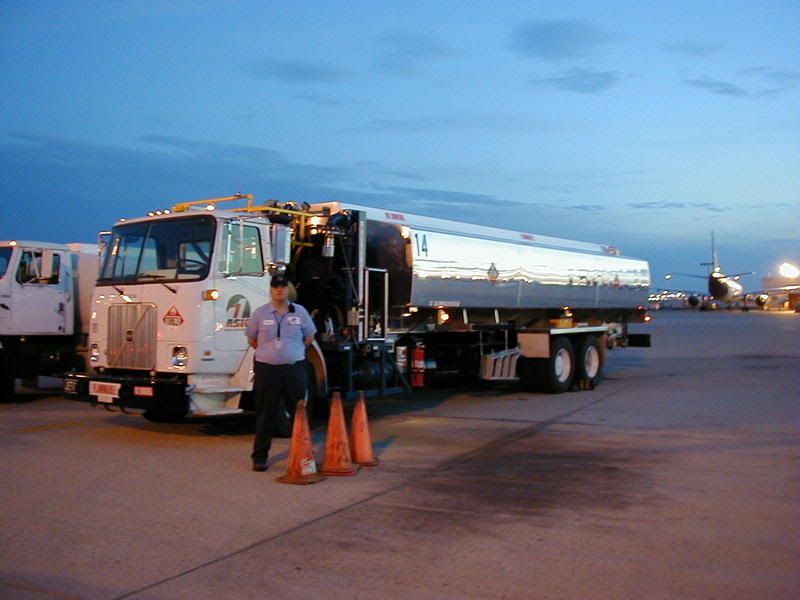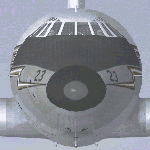Power settings
Moderators: Guru's, The Ministry
- RAF_Quantum
- The Gurus
- Posts: 2745
- Joined: 04 Jul 2004, 23:36
- Location: NE Lincolnshire UK
- Contact:
- Chris Trott
- Vintage Pair

- Posts: 2589
- Joined: 26 Jun 2004, 05:16
- Location: Wichita Falls, Texas, USA
- Contact:
Re: Power settings
John, the numbers are out of the manual for the R4D-6/DC-3"D" which uses Pratt & Whitney twin wasps instead of Curtiss Wright Twin Cyclones which is what the default models. The 30"/2050 is correct for CW engines.johnhinson wrote:I'm new around here so excuse me for jumping in on an old item, but I believe I can correct these figures. The established cruise settings for a DC-3 are 30" MAP/2050 RMP.
This is also the power setting we use on the R4D-6 "Ready4Duty" N151ZE, an R4D-6S.
- johnhinson
- Victor

- Posts: 212
- Joined: 11 Feb 2005, 10:12
- Location: Middle of nowhere
- Contact:
Re: Power settings
Roger that, Chris, I wasn't going by FS models so much as what I haveChris Trott wrote: John, the numbers are out of the manual for the R4D-6/DC-3"D" which uses Pratt & Whitney twin wasps instead of Curtiss Wright Twin Cyclones which is what the default models. The 30"/2050 is correct for CW engines.
seen in the real world which no doubt was of the engine type you say.
Thanks.
John
- Chris Trott
- Vintage Pair

- Posts: 2589
- Joined: 26 Jun 2004, 05:16
- Location: Wichita Falls, Texas, USA
- Contact:
It comes down to the different prop used on the engines that changes the prop RPM setting, but I know from my few flights in "Ready4Duty" that the P&W engines really don't like it when you're using anything other than round hundreds of RPM (1000, 1100, 1200, etc). I don't know if it has to do with the prop governor or not, but a wierd vibration sets up in the engines and you get a pretty pronounced fluctuation in fuel flow when you try and use the Curtiss-Wright prop settings. It's kinda like the difference between the Hamilton-Standard Props and Aeroproducts props on the CV-580 or the two Hamilton-Standard prop designs used on the CV-240/340/440. They all have unique handling attributes and if you mix up which one you're operating, some odd things happen.
Re: Power settings
I know this is an old thread but are there any power setting figures for the Viking anywhere. I have seen the FSNav settings but cannot find the power settings.
Simon

'The trouble with the speed of light is it gets here too early in the morning!' Alfred. E. Neuman

'The trouble with the speed of light is it gets here too early in the morning!' Alfred. E. Neuman
- RAF_Quantum
- The Gurus
- Posts: 2745
- Joined: 04 Jul 2004, 23:36
- Location: NE Lincolnshire UK
- Contact:
- Rick Piper
- The Gurus
- Posts: 4766
- Joined: 18 Jun 2004, 17:20
- Location: In front of screen learning 3ds max :/ ...............Done it :)
Re: Power settings
Hi Simon
Viking 1B (Bristol Hercules 634) 1,690 hp
Empty Weight 23,000 lb
Gross Weight 34,000 lb (24-27 seats)
Admiral Class 36,712 lb (36 seats)
Initial Climb rate 1,500 fpm
Max speed 263 mph
Maximum Range 1,700 nm
Cruise altitude - 3,000 - 10,000 Feet
Max Altitude is 25,000 ft
Max Takeoff power 2,800 RPM +6.75 lbs boost
Max Climb power 2,400 RPM 3.5 lbs Boost, cyl temp 270, Oil 90 deg C(1 hour max) @ 130 mph
Max Continuous rich 2,400 RPM , 3.5 lb Boost, Cyl temp 270, Oil temp 80.
Max Continuous Weak 2,200 RPM, 0 lbs Boost, Cyl Temp 250, Oil temp 80.
Recommended Cruise power 2,300 RPM, 2.5 lbs boost @ 12-17,000 ft
Max cylinder temp for stopping engines 230 deg C.
Not sure how accurate these are as they are from a book i bought recently and have not even loaded Viking for 3 years.
Regards
Rick
Viking 1B (Bristol Hercules 634) 1,690 hp
Empty Weight 23,000 lb
Gross Weight 34,000 lb (24-27 seats)
Admiral Class 36,712 lb (36 seats)
Initial Climb rate 1,500 fpm
Max speed 263 mph
Maximum Range 1,700 nm
Cruise altitude - 3,000 - 10,000 Feet
Max Altitude is 25,000 ft
Max Takeoff power 2,800 RPM +6.75 lbs boost
Max Climb power 2,400 RPM 3.5 lbs Boost, cyl temp 270, Oil 90 deg C(1 hour max) @ 130 mph
Max Continuous rich 2,400 RPM , 3.5 lb Boost, Cyl temp 270, Oil temp 80.
Max Continuous Weak 2,200 RPM, 0 lbs Boost, Cyl Temp 250, Oil temp 80.
Recommended Cruise power 2,300 RPM, 2.5 lbs boost @ 12-17,000 ft
Max cylinder temp for stopping engines 230 deg C.
Not sure how accurate these are as they are from a book i bought recently and have not even loaded Viking for 3 years.
Regards
Rick
- DaveB
- The Ministry
- Posts: 30457
- Joined: 17 Jun 2004, 20:46
- Location: Pelsall, West Mids, UK
- Contact:
Re: Power settings
S T R E W T H..
I've just gone through all of this thinking it was a new thread! :roll: :brick:
:roll: :brick:
The published FSNav figures are based on a climb setting of 2500/+4.5 and a cruise at 8000ft of 2400/+3.9.. and in accordance with information previously received from the maestro ;-) The Boost gauge isn't calibrated in lbs but it will show lbs if you leave the cursor over it. Basically.. 45inhg = 4.5 boost and 39inhg =3.9 boost. The VC1 trio were never the most complete panels ever released but there you go ;-)
EDIT.. having just read Ricks figures.. mine are NOT IAW are they. That said.. this is what I got off him when the aircraft was released and you have to go with what you have. I recently acquired Airlines and Airliners - Vickers Viking but have thus far only looked at the pictures
ATB
DaveB :tab:
I've just gone through all of this thinking it was a new thread!
The published FSNav figures are based on a climb setting of 2500/+4.5 and a cruise at 8000ft of 2400/+3.9.. and in accordance with information previously received from the maestro ;-) The Boost gauge isn't calibrated in lbs but it will show lbs if you leave the cursor over it. Basically.. 45inhg = 4.5 boost and 39inhg =3.9 boost. The VC1 trio were never the most complete panels ever released but there you go ;-)
EDIT.. having just read Ricks figures.. mine are NOT IAW are they. That said.. this is what I got off him when the aircraft was released and you have to go with what you have. I recently acquired Airlines and Airliners - Vickers Viking but have thus far only looked at the pictures
ATB
DaveB :tab:


Old sailors never die.. they just smell that way!
- Garry Russell
- The Ministry
- Posts: 27180
- Joined: 29 Jan 2005, 00:53
- Location: On the other side of the wall
Re: Power settings
That Viking books is good Dave but there's nowt technical as such in that series.
Still nice pics and about thirty paints I got from that
Garry
Still nice pics and about thirty paints I got from that
Garry
Garry

"In the world of virtual reality things are not always what they seem."

"In the world of virtual reality things are not always what they seem."
Re: Power settings
Thankyou very much gentlemen. I will try both sets and see what comes out of it. I am doing the training flights at the moment so I presume it will cost the firm nothing. I will let you know what I get.
Simon

'The trouble with the speed of light is it gets here too early in the morning!' Alfred. E. Neuman

'The trouble with the speed of light is it gets here too early in the morning!' Alfred. E. Neuman




